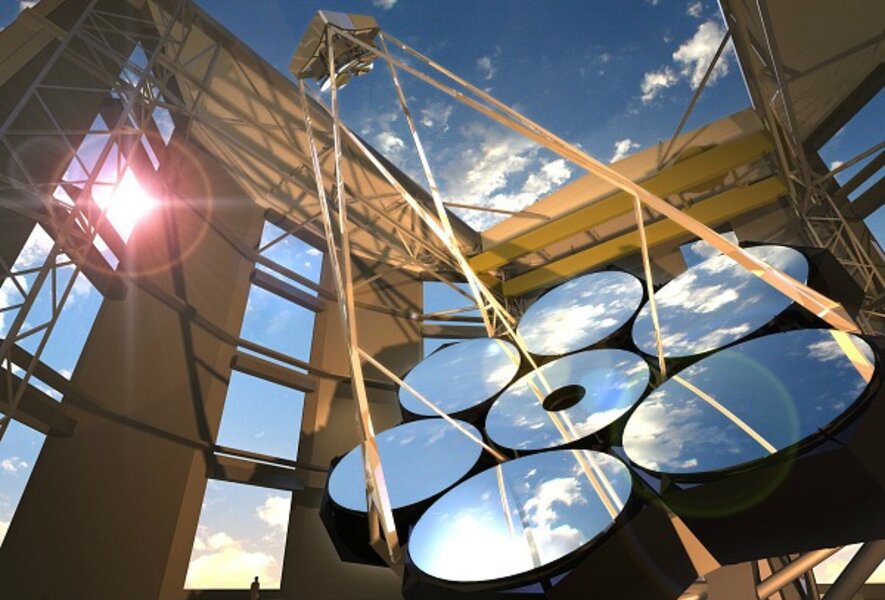Mirrors for giant space telescope take shape
Loading...
In a lab beneath the University of Arizona's football stadium, researchers have reached a new milestone in their effort to build the world's largest ground-based telescope – the Giant Magellan Telescope (GMT), destined for a mountaintop in Chile's Atacama Desert.
On Friday, technicians at the Stewart Observatory Mirror Laboratory opened the lid of a large rotating furnace to reveal the third of seven mirrors, each 27 feet wide, that will operate as one mirror 80 feet across to gather light from the dawn of the universe.
The $880-million GMT is one of two projects currently underway to build a new generation of giant ground-based telescopes to explore the early universe, help identify potentially habitable planets in the sun's neighborhood, and help reveal the nature of dark energy, a mysterious force that is propelling the expansion of the universe at an ever increasing rate.
It's an ambitious agenda that has an additional component often overlooked, notes Wendy Freedman, an astronomer and chair of the Giant Magellan Telescope Organization's board of directors. New capabilities can lead to unimagined discoveries that can profoundly change humanity's view of the universe.
“Galileo had a 2-inch telescope that at the time was the most powerful telescope in the world. It revealed a whole host of things we didn't know about the universe,” says Dr. Freedman, who also heads the Carnegie Observatories. Galileo had no clue that he would discover moons orbiting Jupiter or craters on the moon.
“Nature continues to reveal a lot of secrets, and I think that's one of the things that really excites us about the GMT” and the enhanced capabilities it brings to the table, she says.
From its perch at the Las Campanas Observatory in Chile, the GMT will have a clear view of skies over the southern hemisphere.
A second group is moving ahead on a similar project – a telescope whose primary mirror is 98 feet across. Known as the Thirty Meter Telescope (TMT), this new eye on the cosmos will join other observatories already sitting atop Hawaii's Mauna Kea.
In April, Hawaii's Board of land and Natural Resources granted the project a permit to build the telescope at the site. In July, the project’s partners, which include research institutions from the US, Canada, Japan, China, and India, signed off on an agreement defining the observatory's goals as well as setting out the rights and responsibilities for each of the partners.
Between the two telescopes, astronomers will have access to skies in the northern and southern hemispheres with hardware of comparable capabilities.
Of the two, however, the GMT is farthest along. One mirror is finished, a second is being polished, the third just came out of the oven, glass for the fourth is in hand, and the GMT's board has given the OK to proceed on the fifth mirror.
In March, crews at Las Campanas leveled the summit that the GMT will occupy. Construction is set to begin in mid-2014. The goal is to begin science operations with four mirrors in 2020 and round out the full array by 2024, Freedman says.
The GMT's main mirrors represent the most technically demanding part of the project. In the past with smaller telescopes, a telescope's main light-gathering mirror would be cast as single piece and given its final concave, or parabolic, shape by slowly grinding away at the glass.
The GMT's primary mirror is too large to be cast as a single unit. So designers broke it into seven circular segments that form a reflective rosette.
The mirrors still must undergo a final grinding process – one that must smooth the surface of each mirror to within 1 millionth of an inch. But the six circular mirrors that form the petals must be shaped as parts of the overall parabola that the surfaces of all seven will form. That means that one edge of a “petal” may be as much as 0.55 inches thicker than the opposite edge – all the while ground to the same millionth-of-an-inch tolerance.
No one has designed a mirror array like this before.
“We finished polishing and testing the first mirror a little over a year ago, and that was the biggest technical challenge to the project,” Freedman says, noting simply that without a properly produced primary mirror, there would be no telescope. Now, mirrors are flowing through the process in assembly-line fashion.
Once mirrors are assembled, they will have to be controlled with remarkable precision so that the “virtual” 80-foot mirror retains its optimum shape. That, too presented a challenge that the GMT team feels it has met, Freedman says.
In addition, the team also is working on a technique that combines lasers with hardware that can rapidly deform small segments of the telescope's secondary mirror – also made of seven segments.
The lasers provide information on the atmosphere's distortion. This information ultimately reaches actuators that subtly alter the shapes of the secondary-mirror segments in ways that compensate for the twinkle or distortions turbulence in the atmosphere imparts on light passing through it. It's the latest evolution of a technique known as adaptive optics.
Although in somewhat different form that of the TMT project, the GMT also represents an international collaboration. It includes universities and research institutions from the US, South Korea, and Australia and counts private foundations among its donors.








